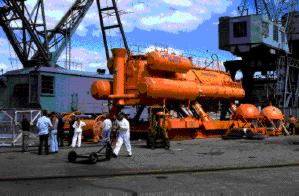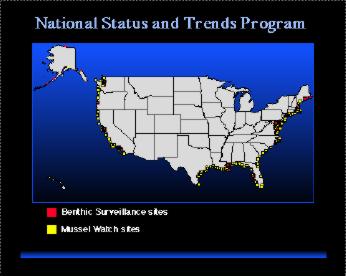1970
The National Oceanic and Atmospheric Administration (NOAA) is
formed. The Bureau of Commercial Fisheries and the saltwater labs
of the BSFW become its National Marine Fisheries
Service. In
subsequent reorgnization actions, the Ann Arbor Biological Station
is moved to the U.S. Fish and Wildlife Service. There is a prposal
to close both the Milford and Ann Arbor Technology Stations. The
Gloucester Lab is moved under the Division of Fishery Products
Technology, Office of Management Services, along with the nation's
other fisheries technology labs.
Bruce L. Freeman and Lionel A. Walford at the Sandy Hook lab
begin collecting information that will eventually become an eight-
section atlas describing sport fish distribution, abundance, life
history, and industry shoreside facilities from the Gulf of Maine
to the Florida Keys. The atlases are published between 1974 and
1976 under the title "Angler's Guide to the United States Atlantic
Coast."
Bureau scientists in La Jolla, Calif., successfully spawn the northern
anchovy in the laboratory, the first time any important commercial
pelagic fish has been induced to spawn under artificial conditions.
1971
 The National Systematics Lab
The National Systematics Lab
The Office of Resource Research is formed. The National
Systematics Lab and the Atlantic Environmental Group are moved into
that office.
The Boothbay Harbor Lab is closed and its functions moved to
the Woods Hole Lab.
The Ann Arbor Fisheries Technology Lab is closed.
Robert White, first NOAA Administrator, establishes four major offshore
fisheries research centers throughout the Nation: the Northwest and
Alaska Fisheries Center (NWAFC), Southwest Fisheries
Center (SWFC),
Northeast Fisheries Center (NEFC), and Southeast Fisheries Center
(SEFC). They report to NMFS headquarters. Three coastal fisheries
research centers, which report to Regional Directors, are also
established: Gulf Coast Fisheries Center (GCFC), Atlantic Estuarine
Fisheries Center (AEFC), and Middle Atlantic Coast Fisheries Center
(MACFC). The basic five-regional office structure is retained.
The Marine Fisheries Advisory Committee (MAFAC) is established by the
Secretary of Commerce to advise on marine fisheries resource issues.
Research on fish protein concentrate production culminates in
construction of an experimental plant (which began operation in
March) and issuance of U.S. Patent 3,598,606 for a novel washing pro-
cedure that removes the bulk of the lipids.
Techniques to reduce mortality of porpoises caught accidentally in
tuna fishing operations are evaluated by the SWFC.
Techniques are developed at the SWFC for rapid countinq and aerial mea-
surement of fish schools by sonar.
NWAFC scientists successfully rear coho salmon in floating saltwater
pens - a technique that shows great promise as a commercial salmon
production venture.
Inexpensive and lightweight deepwater fish traps are developed at the
NWAFC, found to be effective, and are adopted commercially.
NMFS Auke Bay Laboratory scientists survey prior to and after
detonation of nuclear device at Alaska's Amchitka Island; no
significant damage to marine fauna or environment is found.
An international tagging program is reviewed by the NEFC Narragansett
Laboratory which describes blue shark migration routes.
MACFC scientists find fin rot disease in fish to be caused by several
pathogenic bacteria. Incidence of the disease appears to be related to
environmental pollution.
Parasitic amoebae and bacteria from several fish and shellfish are
identified and characterized by MACFC scientists.
SEFC scientists complete an atlas on the distribution of tunas and
billfishes in the Atlantic Ocean.
SEFC scientists successfully test a low light level image intensifier
system to locate fish schools at night by detecting the bioluminescent
halo that surrounds them.
GCFC scientists determine optimum culturing techniques for larval
shrimp and for diatoms used as shrimp food.
GCFC scientists document the rate that fish colonize newly constructed
canals and assess the freshwater requirements of marine fishery
resources in coastal Louisiana and south Florida.
AEFC scientists prove that the Atlantic menhaden resource is composed
of one stock of migrating fish. Gulf research indicates that menhaden
populations east and west of the Mississippi River may constitute
separate stocks.
AEFC scientists develop mathematical models that indicate that a large
proportion of total marine productivity is required to support
exploited fish populations.
The National Fisheries Engineering Laboratory is located at the National
Space Technology Laboratories (Miss.) to launch a remote sensing program
and to modify satellite technology to support fisheries research. It
is renamed the Bay St. Louis Laboratory.
U.S. commercial whaling ends as of December 31st.
1972
NMFS Director Philip Roedel announces that the agency, under NOAA, has
a much broader charter than its predecessor agencies and is now
resource-oriented rather than user-oriented.
The Marine
Mammal Protection Act is passed and establishes a moratorium
on taking marine mammals in U.S. waters and by U.S. citizens on the
high seas.
The Coastal Zone Management Act is passed to provide guidance,
expertise and funding to help states protect and manage U.S. coastal
areas.
Another first, the spawning of haddock in captivity at the NEFC
Narragansett Laboratory, is announced.
A program for reef fishery descriptions and analyses for southeastern
U.S. water begins.
The Bay St. Louis, Miss. Laboratory installs the first computer-based
scientific data-logging system aboard the Albatross
The GCFC is dedicated at Panama City Fla., to study the biology and
ecology of coastal marine fishes, with emphasis on Sport species.
The Central Western and South Pacific Fisheries Development Act is
passed to establish a program for the development of tuna and other
fishery resources of those Pacific regions.
The Fisheries Loan Program receives more than $2.2 million this year.
Since 1956, $31.3 million has been loaned to fishing vessel owners.
1973
The Endangered
Species Act is passed to protect species and populations
whose numbers are small or declining; NMFS is responsible for marine
species under the law.
1974
The Atlantic Environmental Group is moved to the NEFC Narragansett
Laboratory. The group analyzes the marine environment of western North
Atlantic and its influence on fishery resources.
Publication of large volumes on ocean variability within the
U.S. Fishery Conservation Zone begin. Staff at the Narragansett
Laboratory are in the forefront of mapping and tracking physical
and chemical processes in relation to fish distribution, abundance,
and stock composition.
The NMFS-wide Marine Resources Monitoring, Assessment,
and Prediction (MARMAP) Program is established, based largely on
the advice of NEFSC staff members Dr. Ken Sherman and Dr. Robert
Edwards. The project forms the basis for uniform data collection
necessary for fisheries management, and critical to the ecosystems
approaches now being developed by fishery management councils.
Data collected over time includes biological surveys of fish, fish
eggs and larvae, predators, prey, water circulation, sea
temperatures, water column structure, biological production, and
pollution.
The NMFS Atlantic Environmental Group is moved from Washington, D.C.,
to the NEFC Narragansett Laboratory.
The NMFS Gloucester Laboratory initiates a landmark program on
quality assurance of fresh fish fillets, including a U.S. Department
of Commerce Inspection Program, which provides for quality assurance
tests at dockside, at the processing plant, and at retail outlets.
Remote sensing applications to fisheries research in southeastern U.
S. waters are stimulated when SEFC scientists find significant
relationships between water color and Gulf menhaden distribution pat-
terns.
The Auke Bay Laboratory (ABL) in Alaska becomes a part of the NWAFC.
A mandatory Marine Mammal Observer Program is implemented in the U.S.
purseseine fishery for yellowfin tuna in the eastern tropical
Pacific Ocean.
In November, 30,000 young silver salmon reared at the NMFS Tiburon
Laboratory are released. Many will return in 1976 to San Francisco Bay,
which never before had silver salmon
1975
The Mid-Atlantic Center is incorporated into the Northeast
Fisheries Center.
The National Laboratories and Technology Labs are
incorporated into the Centers, with the National Systematics Lab
the AEG, and the Gloucester Tech Lab organized into the NEFC.
 Helgoland undersea habitat
Helgoland undersea habitat
The Helgoland undersea habitat project was conducted in the
Gulf of Maine to study spawning behavior of sea herring. The
equipment belonged to Germany, the project logistics were conducted
by Poland, and scientists on the study hailed from five countries,
including the U.S.
Annual sea scallop surveys begin at the NEFSC, providing a
continuous time series of species information comparable to that
supplied by the finfish survey sampling program since 1963.
The NMFS Tiburon Laboratory near San Francisco becomes another element
of the SWFC.
Some 195 cases are investigated relating to the Marine Mammal Protection Act as are 381 cases involving endangered species and
related products including seizures of quantities of sperm whale oil
and teeth, raw baleen and scrimshaw.
1976
The Magnuson Fisheries
Conservation and Management Act is
signed into law. The NMFS mission becomes the study of
commercially fished species and the environmental factors affecting
their numbers and health.
The Polish Plankton Sorting and Identification Center in
Szczecin, Poland opens for business. The facilities and staff were
established and trained in a multinational effort in order to
process samples taken in the massive ongoing research efforts
during the ICNAF era. Scientists from the NEFSC were instrumental
in training staff to identify and classify zooplankton and in
helping establish laboratory procedures. The Sorting Center proved
so successful that it is still operating today.
The Pacific Environmental Group, now the Pacific Fisheries
Environmental Group (PFEG) in Monterey, Calif., becomes another
element of the SWFC.
The NMFS Southeast Fisheries Center is reorganized to include the
research that had been done under four smaller laboratories.
Headquarters are in Miami,
Fla., and additional research facilities are
in Beaufort, N.C.; Charleston, S.C.; Miami and Panama City, Fla.; Bay
St. Louis and Pascaooula,
Miss.: and Galveston, Tex.
On October 1st, The Northwest Fisheries Center in Seattle officially
becomes the Northwest and Alaska Fisheries Center (NWAFC).
Further NMFS consolidation on the east coast incorporates the Woods Hole, Sandy Hook, and
Narragansett Laboratories with four regional
laboratories into the Northeast Fisheries Center.
The Pacific Utilization Research Center is brought into the NWAFC and
renamed the Utilization
Research (UR) Division.
NMFS Pascagoula Laboratory Harvesting Systems Division develops the
first defined efficiency value (Q) for a sampling trawl.
NMFS agents investigate and assist with a stranding where 28 false
killer whales are successfully unbeached and returned to sea at Dry
Tortugas, Fla. All but one survive.
1977
 A long-term environmental monitoring program was established by the
NEFSC in its Ocean Pulse and Northeast Monitoring Programs. This
project was later expanded to a nationwide project, NOAA's Status and
Trends Program in 1984-85.
A long-term environmental monitoring program was established by the
NEFSC in its Ocean Pulse and Northeast Monitoring Programs. This
project was later expanded to a nationwide project, NOAA's Status and
Trends Program in 1984-85.
During the extremely cold winter of 1977-78, SEFC scientists first
discover the apparent hibernation of sea turtles, finding loggerhead
sea turtles overwintering and sheltered in the mud of the Port
Canaveral, Fla., ship channel.
1978
Dr. Bruce Collette and others publish a paper definitively showing that
Spanish mackerel prevalent in the Gulf of Mexico and along the U.S.
East Coast were a species distinct from Spanish mackerels known in
Brazil. These results convinced U.S. fishery managers not to base
decisions on the only available biological data, which was from the
Brazilian fishery, preventing a sure failure since the Brazilian fish
were larger, and had very different maturity characteristics.
The College Park Technological Laboratory is moved from Maryland to
Charleston, S.C., and renamed the Charleston Laboratory.
The SEFC begins an extensive gear research and development program to
reduce the incidental capture and mortality of sea turtles in shrimp
trawls, leading to the development of various trawling efficiency
devices (TED's).
NMFS conducts tests to develop excluder panels that keep turtles from
being caught in shrimp nets while permitting shrimp harvest.
Loggerhead and green sea turtles are listed as threatened for all
populations worldwide.
On April 1st, four NMFS biologists set up camp in snow caves at Cape
Lisburne, Alaska, to study and count endangered bowhead
whales during
their spring migration.
The Bay St. Louis Laboratory designs an at-sea porpoise impoundment
system for marine mammal research in the Gulf of Mexico.
The NMFS Pascagoula Laboratory and the Engineering Laboratory at Bay
St. Louis, Miss., are merged to form the Mississippi Laboratories.
1979
In February the NWAFC Marine Mammal Division is designated as the
National Marine Mammal Laboratory.
The Mississippi Laboratories designs the prototype satellite-linked
porpoise tracking tag which successfully charts the position of
porpoises off Hawaii.

Home